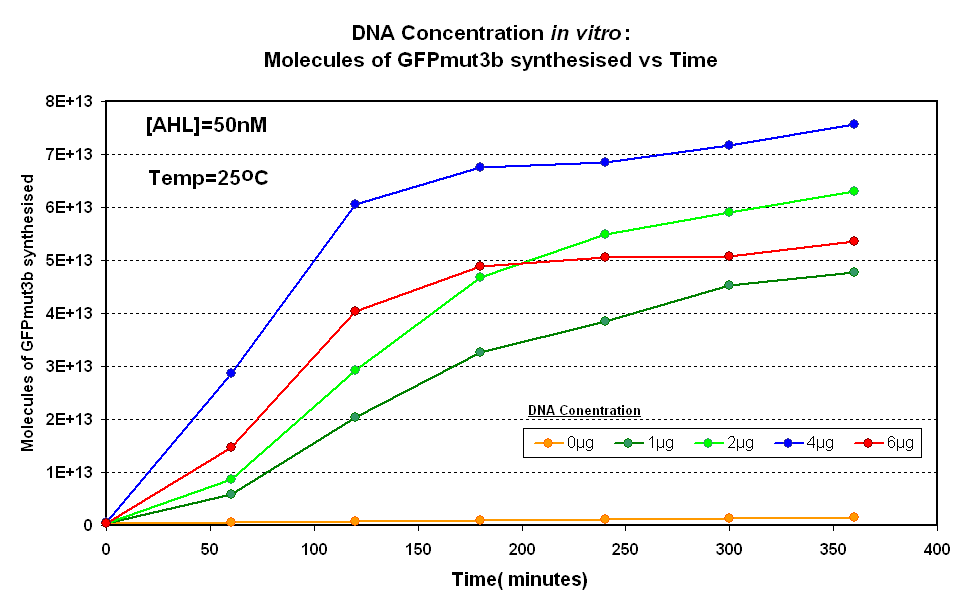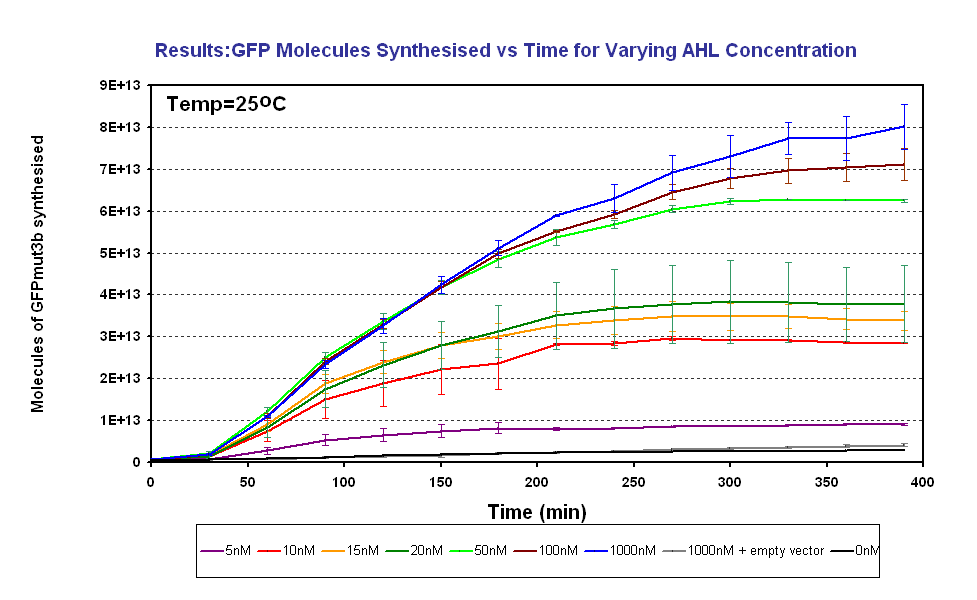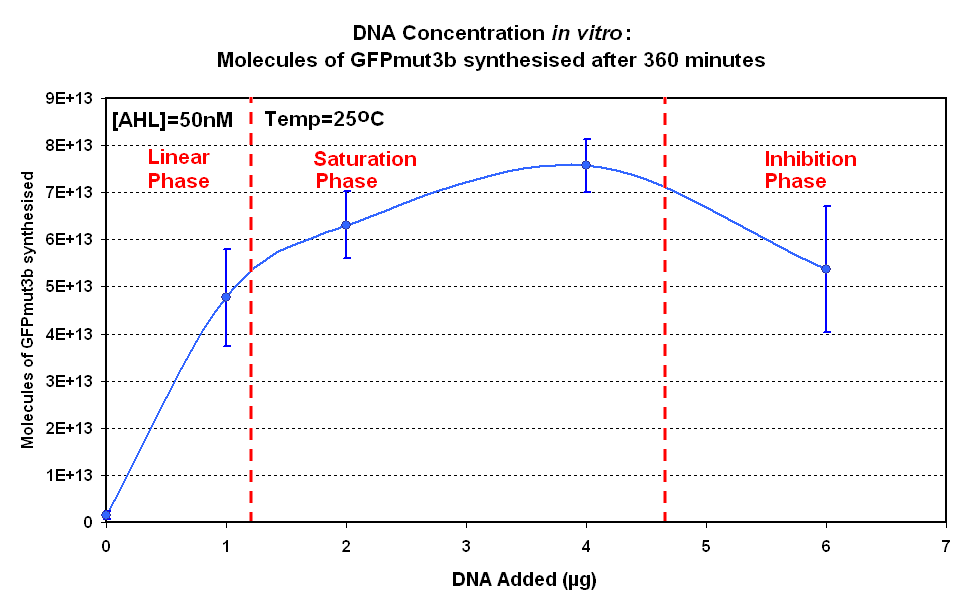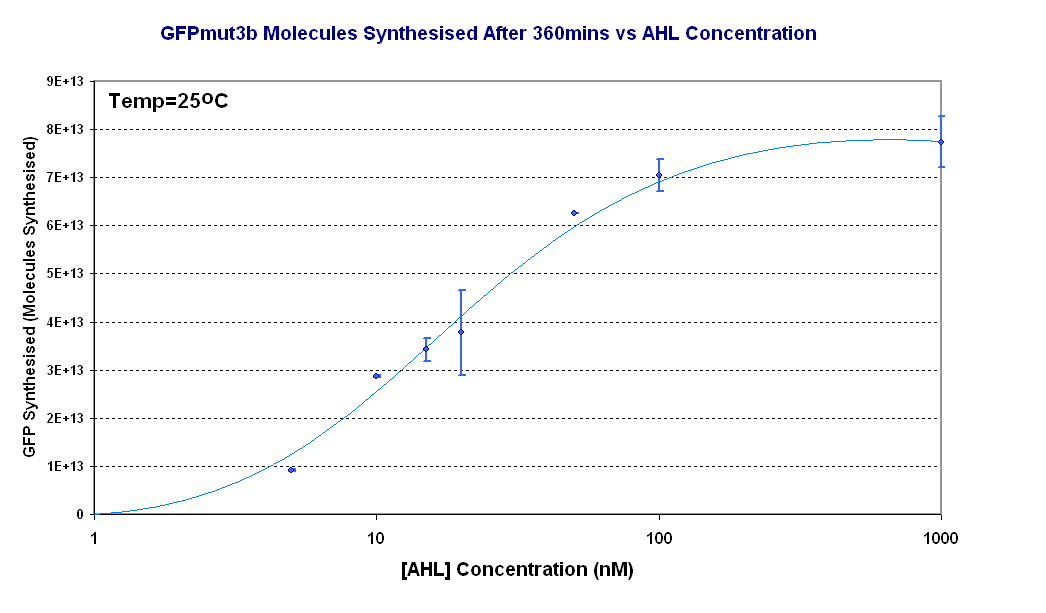Imperial/Infector Detector/Testing
From 2007.igem.org
m (→AHL Testing) |
(→AHL Testing) |
||
| Line 51: | Line 51: | ||
<br clear=all> | <br clear=all> | ||
{|align="center" style="text-align: center; border-top:1px solid #000077; border-right:1px solid #000077; border-bottom:1px solid #000077; border-left:1px solid #000077;" | {|align="center" style="text-align: center; border-top:1px solid #000077; border-right:1px solid #000077; border-bottom:1px solid #000077; border-left:1px solid #000077;" | ||
| - | |<br><center>[[Image:GFPMolecule syn ID2 Final.PNG|thumb|center|420px|left|Fig.1.3: Molcules of GFPmut3b synthesised vs AHL concentrations. The Testing was carried out for the 4µg of DNA. Again the fluorescence reading was converted into GFPmut3b molecules via the calibration curve. Click for full results and protocols can be found on the links [[Imperial/Wet Lab/Results/ID3.1| results]] and [[Imperial/Wet_Lab/Protocols/ID3.1|protocol]] pages.]] | + | |<br><center>[[Image:GFPMolecule syn ID2 Final.PNG|thumb|center|420px|left|Fig.1.3: Molcules of GFPmut3b synthesised vs AHL concentrations at 25<sup>o</sup>C. The Testing was carried out for the 4µg of DNA. Again the fluorescence reading was converted into GFPmut3b molecules via the calibration curve. Click for full results and protocols can be found on the links [[Imperial/Wet Lab/Results/ID3.1| results]] and [[Imperial/Wet_Lab/Protocols/ID3.1|protocol]] pages.]] |
| - | [[Image:Titrations curve - molecules.PNG|thumb|440px|right|Fig.1.4:Molecules of GFPmut3b synthesised for each DNA Concentration ''in vitro'', after 360 minutes. The data is from the fluorescence measurement at 360minutes which was converted to GFPmut3b molecules and plotted against [AHL]. The scale on the X axis is a logarithmic scale.]]</center> | + | [[Image:Titrations curve - molecules.PNG|thumb|440px|right|Fig.1.4:Molecules of GFPmut3b synthesised for each DNA Concentration ''in vitro'', after 360 minutes at 25<sup>o</sup>C. The data is from the fluorescence measurement at 360minutes which was converted to GFPmut3b molecules and plotted against [AHL]. The scale on the X axis is a logarithmic scale.]]</center> |
|- | |- | ||
|style="text-align: left;" |<br> | |style="text-align: left;" |<br> | ||
Revision as of 01:08, 27 October 2007

Infector Detector: Testing
Summary
The key results of the testing were:
- The optimum DNA concentration for [http://partsregistry.org/Part:BBa_T9002 pTet-LuxR-pLux-GFPmut3b] in our Commcercial S30 Cell extract is 4µg.
Aims
From the initial testing we determined that the construct worked in both in vivo and in vitro. Now we were concerned with:
- Optimization - To test and obtain the optimal DNA concentration for construct 1 in vitro to reach the full potential of our infecter detector system.
- Test our specifications - To test the range 5-50nM AHL defined in our specifications and characterise the output of GFPmut3b for a range of AHL inputs. We aimed to measure fluorescence and using our calibration curve convert to molecules of GFPmut3b, click here for our calibration curve and for how we used it to convert
Results
DNA Concentrations
 Fig.1.1:Molecules of GFPmut3b synthesised over time, for each DNA Concentration in vitro - The fluorescence was measured over time for each experiment and converted into molecules of GFPmut3b in vitro using our calibration curve Click here for results and protocol. |
The Results above show that the optimum DNA concentration for in vitro is 4µg for 50nM AHL. From figure 1.1. and 1.2 it can be seen that as DNA concentration increases above 4µg the GFPmut3b molecules synthesised decrease. Interestingly for figure 1.2 the graph can be split into several regions of how the DNA concentration changes the output of GFPmut3b synthesis:
The fact that increasing DNA concentration above 4µg causes a decrease in rate of protein synthesis is very interesting. The reason for this is thought to be that increasing DNA concentration causes problems with premature translational termination. |
AHL Testing
 Fig.1.3: Molcules of GFPmut3b synthesised vs AHL concentrations at 25oC. The Testing was carried out for the 4µg of DNA. Again the fluorescence reading was converted into GFPmut3b molecules via the calibration curve. Click for full results and protocols can be found on the links results and protocol pages. |
Figure 1.3 shows us the following:
Figure 1.4 shows us the following:
|

